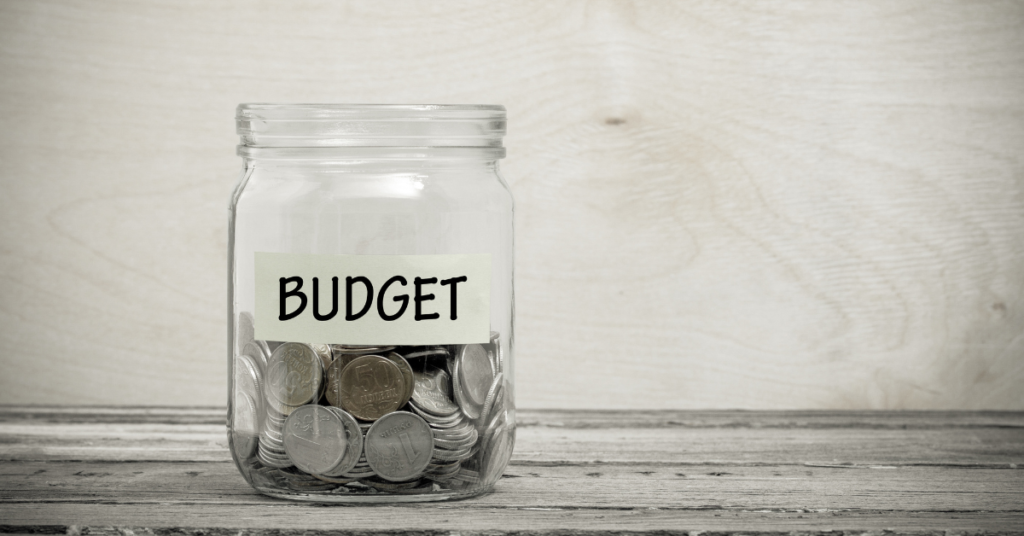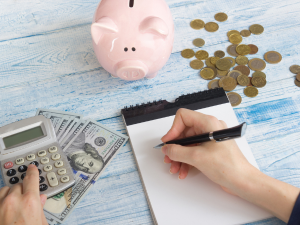
What is the 50-30-20 Budget?
The 50-30-20 budget method is a popular option for setting up a budget due to its straight-forward nature. As the name suggests, you split your take-home income into 3 different categories.
- 50% of your budget goes to pay for all your needs
- 30% of your budget goes to your wants
- 20% of your budget goes to savings or paying off debt
How to Set Up a 50-30-20 Budget
Step 1: Determine your available category totals by percentage using your take-home pay.
The first step when setting up this budgeting method (or any other method for that matter) is to determine your take-home pay for the month. You will come up short each month if you use your gross pay instead of your net pay.
You’ll split up your income into 50%, 30%, and 20% to determine your available amounts for each category.
- Add your paychecks for a typical month to determine your take-home pay
- Multiply by 0.5 to determine the amount available for needs
- Multiply by 0.3 to determine the amount available for wants
- Multiply by 0.2 to determine the amount available for savings (or debt repayment)

Step 2: Determine your typical category expenditures by looking at your typical monthly spending.
The second step is to determine whether the percentages are realistic for your current situation. You will have to determine the typical dollar amount needed for each category type. If you write down everything you spend money on along with the amount, you will get a clear picture of your expenditures. This may seem tedious, but it can help you get a much closer estimation of the amount you spend on each category every month. It may also help to look back at bank/credit card statements to get a true sense of where your money has been going. Below are common expenses to include when determining what goes into the needs, wants, and savings categories.
| Needs | Wants | Savings/Debt Repayment |
| Mortgage/Rent Utilities (Gas, Electric, Water, Trash, etc.) Insurance (Home/Renters, Life, Car, Health, etc.) Phone Internet Car Expenses (Maintenance, Gas, Loan, Insurance) Groceries Household Products (cleaning, paper products, maintenance supplies, etc.) Work Related Expenses (licensure, courses, supplies, clothes, etc.) Clothing (needed clothing) Medical | Entertainment Hobbies Cable and/or Streaming Services Clothing (wanted) Memberships Eating Out Donations Gifts | Emergency Fund High-Interest Debt Car Loan Personal Loans Retirement Accounts Investment Accounts Sinking Funds |
If you don’t have enough income to pay for your needs, there are a few options for you. First, check to see if there are any needs that can be reduce or cut out completely. Second, you could adjust your wants category and shift some funds over to the needs to cover the deficit. Lastly, come up with ways to increase your income. Check out my blog post on Ways to Increase Your Income.
Step 3: Finalize the category amounts and track your spending
After shifting your category totals, you need to complete the most important task that comes with budgeting…following the budget! It does absolutely no good to create a budget if you aren’t tracking you expenses throughout the month and making sure that you are staying within the allotted amounts.
Using your 50-30-20 Budget
Each month you should use some sort of tracking method to keeping your spending in check and determine how well your budget is working for you. I like to track my spending as well as my savings. This is not only helpful for staying in control of your finances but can be quite motivational as well.
As you track your expenses, you may find that there is an expense or category that is consistently going over (or under) budget. You can make adjustments to the wants and needs categories to address the problem. After making your initial budget, you are not stuck with that for the long-haul. Budgets will change based on many factors. The important thing is that you know where your money is going each month and that you are putting at least 20% toward savings (or debt repayment if you have any debt).
Finally, I would like to mention is that you can switch the wants and savings percentages if you are trying to build up your savings or reduce your debt faster.
Pros
The 50-30-20 budget method is appealing for a multitude of reasons.
- Easy to Use: It can be helpful for those that are new to budgeting. This method is easy to get started with as the rule for how much you should spend on each category is set for you.
- Open-Ended: For those who don’t like a lot of restrictions, this method is nice since the categories are broad.
- Adaptable: Because of the broad categories, you can easily adjust your budget as your needs/wants/savings change each month.
Cons
- Open-Ended: Both a pro and a con because by not having more categories it is far too easy to overspend too early in the month.
- Often Unrealistic/Impossible: Depending on your income and/or where you live, 50% of your income may be too little to pay for all of your needs.
Hopefully this helps you get started in creating and using your 50-30-20 budget. If this method doesn’t call out to you, there are other methods you can try as well. The type of budget you choose to use isn’t important. Just having a budget in place and using it is the most important thing you can do to keep spending in check and know where your money is going each month.
